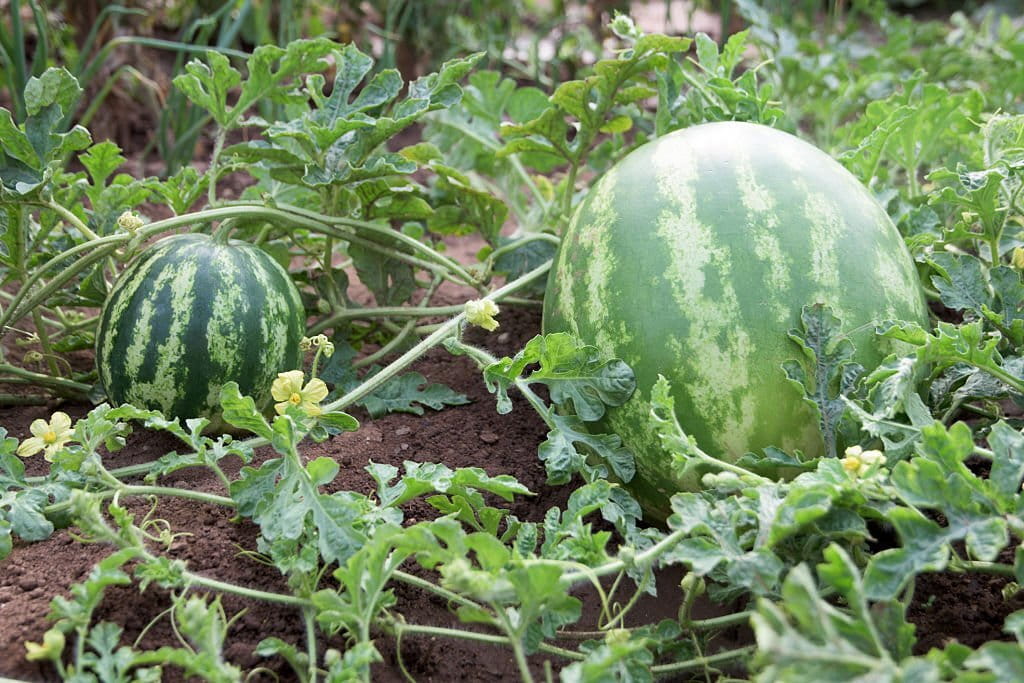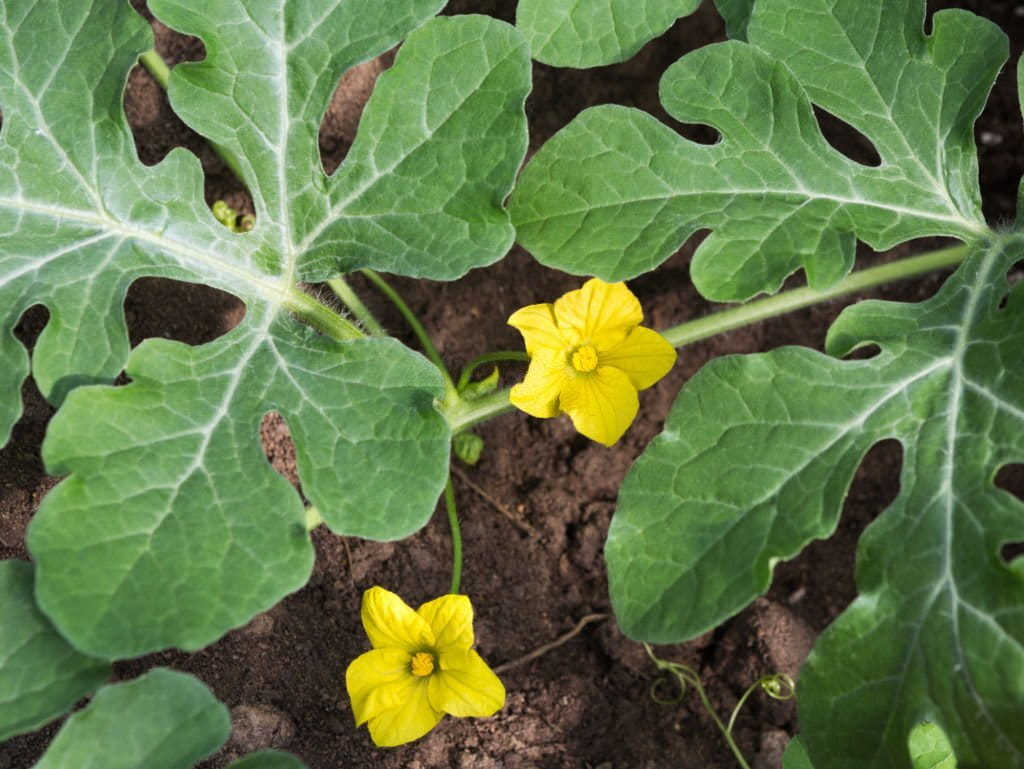Following the article on how to tell if watermelon is pollinated, you’ll undoubtedly be interested in learning more about watermelon growing stages.
The edible fruit of the watermelon (Citrullus lanatus) is a flowering plant species of the Cucurbitaceae family. It is a highly cultivated fruit with over 1,000 variations. It is a scrambling and trailing vine-like plant.
Watermelon is grown in a variety of temperatures around the world, from tropical to temperate, for its enormous edible fruit, which is a berry with a hard skin and no internal divisions and is botanically known as a pepo.
Although seedless cultivars exist, the luscious, juicy flesh is usually deep crimson to pink, with abundant black seeds. The rind is edible after cooking, and the fruit can be eaten fresh or pickled. It can also be drunk as a juice or as part of a mixed drink.
So, how does this nutrient-dense fruit grow? Let’s find out in the following article.

Watermelon growing stages
It takes roughly 30-35 days from the moment the female flower is pollinated until the fruit is mature, depending on the type. The entire process is detailed below, from seed to harvest.
1. Seed
The seed stage is the first step of watermelon development. It simply indicates that the watermelon is in the shape of a seed. The seed of a watermelon is small, firm, smooth, and black in color. That is one of its features.
When a dried watermelon seed is pressed hard enough, it can sprout. There are also occasions when the seeds are soft and white in color, and only a small percentage of those seeds grow. It must have a hard that will undoubtedly grow.
Many seeds can be found in single watermelon fruit. Each watermelon fruit contains approximately 40 to 60 seeds. Making the fruit ripe is a technique for obtaining high-quality seeds for planting. Make it look as mature as possible. It will turn green and ripe, yielding good seeds.
2. Germinating
The watermelon will begin to germinate during this stage of development.
Watermelon seeds that are germinating will have a high germination percentage if the seeds are of good quality. Seeds that are developed and capable of growing are considered to be of high quality.
If you wish to germinate and cultivate seeds, you should start by growing them in a seedbox. The seedbox has a number of little containers in which the seeds can be planted and grown. Fill each container with dirt first, and then one watermelon seed. After that, cover it with soil and water it.
The watermelon seeds will germinate after 4 to 14 days. It takes a few days for the roots to appear, and then you’ll see some little leaves.
3. Young Seedling
The seedling stage is the first stage of growth. The watermelon is a little plant with sprouting roots and a couple of leaves.
Watermelon seedlings require extra attention due to their delicate stems. Miss care has the ability to cut its stem, causing it to dry out and stop growing. It would be beneficial if you protected it from the strong winds and animals. The leaves are edible to animals.
When watermelon seedlings germinate properly, they are fantastic. Watermelon seedlings can be transplanted when they have more leaves and are 6 to 10 inches long. It will be able to flourish in this manner. It requires sufficient water to thrive.
4. Vining
The first genuine leaves emerge from the stem five to ten days after germination. Photosynthesis, the process by which plants use sunlight to convert carbon dioxide and water into food, is possible on these leaves.
A one-foot-long vine emerges, with huge lobed leaves beginning to sprout. They will continue to develop until they reach a length of about 12 feet. A month after the initial vine is sent out by a watermelon plant, numerous other vines will begin to sprout.
On all of the vines, leaves begin to sprout and get larger. Top-dress plants with 1/2 cup bone meal at this time, gently working it into the soil to avoid damaging short roots.
5. Flowering

A watermelon produces male and female flowers around two weeks after it is harvested. The male flowers are the first to bloom. Pollen is produced, but no fruit is produced. The female flowers appear after the male blooms have bloomed. Because watermelon blossoms only endure one day, a sufficient number of bees and other pollinators must be present when the blooms are viable.
Hand pollination may be necessary if your garden is in a location where bees are few. Remove the male flower’s petals to reveal the pollen-covered anther. To pollinate the female flowers, brush the pollen from this onto the center of the female flowers.
6. Bearing Watermelon
Female watermelon blooms begin to develop fruit once they have been pollinated. Underneath the blooms, tiny green balls begin to swell. When the fruit starts to set, fertilize the watermelon plants with a 5-10-10 fertilizer. Provide at least one inch of water every week until the watermelon plants begin to bear fruit.
Even when it is very young, the watermelon has stripes on its body. When young, it has green smooth tiny fruits that become larger as it matures.
The watermelon is 70 to 80 days old when it begins to bear fruit. Pests can attack the watermelon fruits, thus it requires extra attention.
The fruit can take up to a month to fully ripen, depending on the watermelon variety. It’s not always easy to tell when the melons are totally ripe, especially early in the season.
The tendrils on the vine shift from green to brown, the patch on the ground where the melon was lying changes from white to yellow, and the sound generated when you thump the watermelon changes to a hollow sound, to name a few symptoms.
7. Harvesting
The watermelon is at this stage of development and is ready to be harvested. It denotes that the watermelon has reached its full maturity.
When the watermelon fruit has a hard fruit, you can now acquire it. It would be beneficial if you checked for its color as well. The color of a mature watermelon fruit should range from light green to dark green. It also means it’s almost ready to eat.
8. Drying
The watermelon turns yellow and begins to dry at this point. When the seeds inside dry up, they will become tougher.
The fruits are ripening and will erupt soon. During this period, you can continue to use the seeds to develop them in a cycle. It can take days or weeks for the water to evaporate.
Read more: How To Grow Watermelon In A Small Space?
How long does it take for a watermelon to grow?
It takes three months for it to reach full maturity. Sprouting, vining, and flowering take place within the first two months of the plant’s life. The genuine fruit will only develop in the last month of growing. After sowing the seed, you should be able to harvest in about three months.
The length of time it takes for a plant to mature from a seed varies depending on the variety. Smaller cultivars mature faster and are ready to harvest before larger ones.
Frequently Asked Questions
Here are a few questions that many people also wonder. Take a look at some of the information below.
Q: When is the best time to plant watermelon?
Watermelon demands a long growing season (about 80-90 days after seed sowing), and it despises chilly temperatures. Plant your watermelon when the soil temperature has reached around 70 degrees Fahrenheit and there are no more cool nights in the forecast. This is actually two to three weeks after the last frost date in the spring for many individuals.
Q: Do watermelons require a lot of water to grow?
Watermelons, like most other plants in your veggie garden, require 1 to 2 inches of water per week to thrive. This is especially critical when the watermelon plants are fruiting. Watermelon is 92 percent water, so keep your plants well-watered if you want big, juicy watermelons!
Q: Do my watermelon plants need to be fertilized?
Watermelon plants are heavy feeders and benefit from fertilization on a regular basis. While the plants are growing their stems, leaves, and canopy, we recommend using a nitrogen-rich fertilizer like diluted fish emulsion. However, after the plants begin to set fruit, you can switch to a fertilizer that contains more phosphorus and potassium to aid the fruit set.
Q: What is the maximum number of watermelons that a single plant can yield?
The number of melons you obtain from your plants will be determined by the cultivar you choose, the amount of bee and pollinator activity in your garden, and your growing conditions. However, each vine should yield at least 1-2 watermelons.
Q: How long does a watermelon take to reach its full size?
To develop a full-size watermelon, it takes 80-90 days from seed sowing to harvest. Watermelons of lesser sizes can mature in as little as 70 days.
Final thoughts
We discussed the development of watermelon in detail in the preceding post. Do you have any further queries concerning this well-known fruit? Please leave a remark below and we will assist you in finding an answer! I hope you found the information in this post useful.